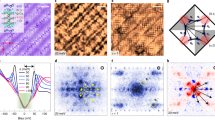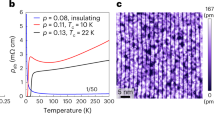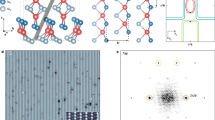Abstract
The defining characteristic1,2 of Cooper pairs with finite centre-of-mass momentum is a spatially modulating superconducting energy gap Δ(r), where r is a position. Recently, this concept has been generalized to the pair-density-wave (PDW) state predicted to exist in copper oxides (cuprates)3,4. Although the signature of a cuprate PDW has been detected in Cooper-pair tunnelling5, the distinctive signature in single-electron tunnelling of a periodic Δ(r) modulation has not been observed. Here, using a spectroscopic technique based on scanning tunnelling microscopy, we find strong Δ(r) modulations in the canonical cuprate Bi2Sr2CaCu2O8+δ that have eight-unit-cell periodicity or wavevectors Q ≈ (2π/a0)(1/8, 0) and Q ≈ (2π/a0)(0, 1/8) (where a0 is the distance between neighbouring Cu atoms). Simultaneous imaging of the local density of states N(r, E) (where E is the energy) reveals electronic modulations with wavevectors Q and 2Q, as anticipated when the PDW coexists with superconductivity. Finally, by visualizing the topological defects in these N(r, E) density waves at 2Q, we find them to be concentrated in areas where the PDW spatial phase changes by π, as predicted by the theory of half-vortices in a PDW state6,7. Overall, this is a compelling demonstration, from multiple single-electron signatures, of a PDW state coexisting with superconductivity in Bi2Sr2CaCu2O8+δ.
This is a preview of subscription content, access via your institution
Access options
Access Nature and 54 other Nature Portfolio journals
Get Nature+, our best-value online-access subscription
$29.99 / 30 days
cancel any time
Subscribe to this journal
Receive 51 print issues and online access
$199.00 per year
only $3.90 per issue
Buy this article
- Purchase on Springer Link
- Instant access to full article PDF
Prices may be subject to local taxes which are calculated during checkout




Similar content being viewed by others
Data availability
The data that support the findings of this study are available from the corresponding author upon reasonable request.
References
Fulde, P. & Ferrel, R. A. Superconductivity in a strong spin-exchange field. Phys. Rev. 135, A550 (1964).
Larkin, A. I. & Ovchinnikov, Yu. N. Inhomogeneous state of superconductors. Sov. Phys. JETP 20, 762–769 (1965).
Fradkin, E., Kivelson, S. A. & Tranquada, J. M. Colloquium: theory of intertwined orders in high temperature superconductors. Rev. Mod. Phys. 87, 457–482 (2015).
Agterberg, D. F. et al. The physics of pair density waves: cuprate superconductors and beyond. Preprint at https://arxiv.org/abs/1904.09687 (2019).
Hamidian, M. H. et al. Detection of a Cooper-pair density wave in Bi2Sr2CaCu2O8+δ. Nature 532, 343–347 (2016).
Agterberg, D. F. & Tsunetsugu, H. Dislocations and vortices in pair-density-wave superconductors. Nat. Phys. 4, 639–642 (2008).
Berg, E., Fradkin, E. & Kivelson, S. A. Charge-4e superconductivity from pair-density-wave order in certain high-temperature superconductors. Nat. Phys. 5, 830–833 (2009).
Norman, M. R., Pines, D. & Kallin, C. The pseudogap: friend or foe of high T c? Adv. Phys. 54, 715–733 (2005).
Li, Q., Hücker, M., Gu, G. D., Tsvelik, A. M. & Tranquada, J. M. Two-dimensional superconducting fluctuation in stripe-ordered La1.875Ba0.125CuO4. Phys. Rev. Lett. 99, 067001 (2007).
Berg, E., Fradkin, E., Kivelson, S. A. & Tranquada, J. M. Striped superconductors: how spin, charge, and superconducting orders intertwine in the cuprates. New J. Phys. 11, 115004 (2009).
Berg, E. et al. Dynamical layer decoupling in a stripe-ordered high-T c superconductor. Phys. Rev. Lett. 99, 127003 (2007).
He, R.-H. et al. From a single-band metal to a high-temperature superconductor via two thermal phase transitions. Science 331, 1579–1583 (2011).
Lee, P. A. Amperean pairing and the pseudogap phase of cuprate superconductors. Phys. Rev. X 4, 031017 (2014).
Norman, M. R. & Davis, J. C. Quantum oscillations in biaxial pair density wave state. Proc. Natl Acad. Sci. USA 115, 5389–5391 (2018).
Himeda, A., Kato, T. & Ogata, M. Stripe states with spatially oscillating d-wave superconductivity in the two-dimensional t−t′−J model. Phys. Rev. Lett. 88, 117001 (2002).
Raczkowski, M., Capello, M., Poilblanc, D., Frésard, R. & Oleś, A. M. Unidirectional d-wave superconducting domains in the two-dimensional t−J model. Phys. Rev. B 76, 140505 (2007).
Yang, K.-Y., Chen, W. Q., Rice, T. M., Sigrist, M. & Zhang, F.-C. Nature of stripes in the generalized t–J model applied to the cuprate superconductors. New J. Phys. 11, 055053 (2009).
Loder, F., Graser, S., Kampf, A. P. & Kopp, T. Mean-field pairing theory for the charge-stripe phase of high-temperature cuprate superconductors. Phys. Rev. Lett. 107, 187001 (2011).
Corboz, P., Rice, T. M. & Troyer, M. Competing states in the t–J model: uniform d-wave state versus stripe state. Phys. Rev. Lett. 113, 046402 (2014).
Tu, W.-L. & Lee, T.-K. Genesis of charge orders in high temperature superconductors. Sci. Rep. 6, 18675 (2016).
Choubey, P., Tu, W.-L., Lee, T. K. & Hirschfeld, P. J. Incommensurate charge ordered states in the t–t′–J model. New J. Phys. 19, 013028 (2017).
Verret, S., Charlebois, M., Sénéchal, D. & Tremblay, A.-M. S. Subgap structures and pseudogap in cuprate superconductors: role of density waves. Phys. Rev. B 95, 054518 (2017).
Edkins, S. D. et al. Magnetic field–induced pair density wave state in the cuprate vortex halo. Science 364, 976–980 (2019).
Rajasekaran, S. et al. Probing optically silent superfluid stripes in cuprates. Science 359, 575–579 (2018).
Mesaros, A. et al. Topological defects coupling smectic modulations to intra-unit-cell nematicity in cuprates. Science 333, 426–430 (2011).
Fujita, K. et al. in Strongly Correlated Systems: Experimental Techniques (eds Avella, A. & Mancini, F.) Ch. 3 (Springer, 2015).
Fujita, K. et al. Direct phase-sensitive identification of a d-form factor density wave in underdoped cuprates. Proc. Natl Acad. Sci. USA 111, E3026–E3032 (2014).
Nie, L., Tarjus, G. & Kivelson, S. A. Quenched disorder and vestigial nematicity in the pseudogap regime of the cuprates. Proc. Natl Acad. Sci. USA 111, 7980–7985 (2014).
Agterberg, D. F. & Garaud, J. Checkerboard order in vortex cores from pair-density-wave superconductivity. Phys. Rev. B 91, 104512 (2015).
Dai, Z., Zhang, Y.-H., Senthil, T. & Lee, P. A. Pair-density waves, charge-density waves, and vortices in high-T c cuprates. Phys. Rev. B 97, 174511 (2018).
Wang, Y. et al. Pair density waves in superconducting vortex halos. Phys. Rev. B 97, 174510 (2018).
Cho, D. et al. A strongly inhomogeneous superfluid in an iron-based superconductor. Nature 571, 541–545 (2016).
Norman, M. R. & Davis, J. C. Quantum oscillations in a biaxial pair density wave state. Proc. Natl Acad. Sci. USA 115, 5389–5391 (2018).
Acknowledgements
We thank S. D. Edkins, E. Fradkin, M. H. Hamidian, S. A. Kivelson, P. A. Lee and J. M. Tranquada, for discussions and advice. Z.D., H.L., K.F. G.G. and P.D.J. acknowledge support from the US Department of Energy, Office of Basic Energy Sciences, under contract number DEAC02-98CH10886. S.H.J. and J.L. acknowledge support from the Institute for Basic Science in Korea (grant number IBS-R009-G2), the Institute of Applied Physics of Seoul National University and a National Research Foundation of Korea (NRF) grant funded by the Korea government (MSIP) (number 2017R1A2B3009576). E.P.D. was supported by the Brookhaven National Laboratory Supplemental Undergraduate Research Program (SURP). J.C.S.D. acknowledges support from the Science Foundation of Ireland under award SFI 17/RP/5445 and from the European Research Council (ERC) under award DLV-788932.
Author information
Authors and Affiliations
Contributions
K.F. designed and led the project. Z.D., H.L., S.H.J., E.P.D. and K.F. carried out experiments at the MIRAGE STM of the OASIS complex at Brookhaven National Laboratory; G.G. synthesized and characterized the samples; Z.D., H.L. and K.F. developed and carried out analysis. K.F. wrote the paper with key contributions from J.C.S.D, Z.D., H.L., J.L. and P.D.J. The manuscript reflects the contributions and ideas of all authors.
Corresponding author
Ethics declarations
Competing interests
The authors declare no competing interests.
Additional information
Peer review information Nature thanks Ting-Kuo Lee, Yi Yin and the other, anonymous, reviewer(s) for their contribution to the peer review of this work.
Extended data figures and tables
Extended Data Fig. 1 Analysis of the tip isotropy.
a, Topography T(r) within 40 nm × 40 nm FOV. b, Real part of Fourier transform of T(r). c, Line profile ReT(q) along the line in the middle panel, representing nearly equal Bragg peak height (difference is less than 7%).
Extended Data Fig. 2 Estimation of the nanoflake tip geometry.
a, Autocorrelation of Δ(r). b, Line profile measured from centre in a is azimuthal-angle averaged. The size of the nanoflake on the tip is estimated from the full-width at half-maximum and is around 3.3 nm.
Extended Data Fig. 3 Possible process of the Josephson tunnelling.
Schematic representation of planar Josephson tunnelling in the presence of two order parameters (OPs): homogeneous SC and PDW.
Extended Data Fig. 4 Preliminary experimental data analysis.
a, c, Preliminary Δ(r) independently measured at 4.2 K on different pieces of nearly optimally doped Bi2Sr2CaCu2O8+δ. b, d, The magnitude of Fourier transform of Δ(r) in a and c, respectively, representing early observations of 1/8 peaks marked by the red circles.
Extended Data Fig. 5 Differential conductance map and its ratio.
a, g(r, E = 54 meV) map. The eight-unit-cell CDW modulation, that is, the PDW induced N(r) modulation at Q, can be seen. b, Z(r, E = 54 meV) calculated by Z(r, E) = g(r, E)/g(r, −E).
Extended Data Fig. 6 Cut-off-length dependence of \(|{{\bf{D}}}_{2{{\bf{Q}}}_{{\boldsymbol{x}}}}^{{\boldsymbol{Z}}}({\bf{r}})|\) and \(|{{\boldsymbol{\Delta }}}_{{{\bf{Q}}}_{{\boldsymbol{x}}}}({\bf{r}})|\).
The left column shows \(|{D}_{2{{\bf{Q}}}_{{\boldsymbol{x}}}}^{Z}({\bf{r}})|\) at different cut-off lengths, similarly for the right column for \(|{\varDelta }_{{{\bf{Q}}}_{{\boldsymbol{x}}}}({\bf{r}})|\).
Extended Data Fig. 7 Distance analysis.
a, A count distribution sorted by distances between the topological defects in the induced N(r) modulation at 2Q from Fig. 4b and the nearest point on the yellow strings in the PDW phase map from Fig. 4c. b, Average distribution of 100 configurations, within each configuration 25 points are randomly generated in the same FOV and distances to the same yellow strings are calculated and sorted.
Extended Data Fig. 8 Spatial evolution of the PDW phase.
a, A phase map \({\varPhi }_{{{\bf{Q}}}_{{\boldsymbol{x}}}}^{\varDelta }({\bf{r}})\) of the PDW order. Three representative contours surrounding the 2π topological defects from \({\varPhi }_{2{{\bf{Q}}}_{{\boldsymbol{x}}}}^{Z}({\bf{r}})\) across the yellow strings. b, An evolution of the phase along each contour in a. The upside-down black triangle marks the starting point of winding and the upright black triangle marks the ending point, in correspondence with the winding directions in a. π phase windings are clearly seen in the PDW phase surrounding the 2π topological defects from \({\varPhi }_{2{{\bf{Q}}}_{{\boldsymbol{x}}}}^{Z}({\bf{r}})\).
Rights and permissions
About this article
Cite this article
Du, Z., Li, H., Joo, S.H. et al. Imaging the energy gap modulations of the cuprate pair-density-wave state. Nature 580, 65–70 (2020). https://doi.org/10.1038/s41586-020-2143-x
Received:
Accepted:
Published:
Issue Date:
DOI: https://doi.org/10.1038/s41586-020-2143-x
This article is cited by
-
Low-Field Hall effect, Pseudogap and Magnetic Textures in the Bi\(_{2}\)Sr\(_{2}\)CaCu\(_{2}\)O\(_{8+x}\) Superconductor
Journal of Superconductivity and Novel Magnetism (2024)
-
Detection of a pair density wave state in UTe2
Nature (2023)
-
Mechanism for fluctuating pair density wave
Nature Communications (2023)
-
Pair density wave state in a monolayer high-Tc iron-based superconductor
Nature (2023)
-
Low-energy gap emerging from confined nematic states in extremely underdoped cuprate superconductors
npj Quantum Materials (2023)
Comments
By submitting a comment you agree to abide by our Terms and Community Guidelines. If you find something abusive or that does not comply with our terms or guidelines please flag it as inappropriate.



